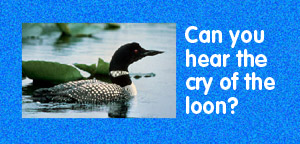This season's articles (Excerpted from our printed newsletter):
The Common Loon
Listen. That eerie sound you hear is not a ghost haunting a northern lake. It's the call of the Common Loon. This bird, whose ancestors roamed the earth 65 million years ago, can be found on Wisconsin's northern lakes in the summer. They come here to breed and raise their young. Come fall, they head back to the ocean coasts and stay there for the winter.
 The loon's diet consists of perch, bullhead, sunfish, trout, bass, frogs, crayfish and even leeches. Their long pointed beak allows them to grab fish underwater and then swallow them in one gulp. Their topedo-like body is streamlined for swimming underwater. The legs of a loon are set far back on its body to work like oars with its large webbed feet. The body color, dark on top and light on the bottom makes loons less visible to fish as they swim. Some scientists believe the loon's red eyes help it see better underwater.
The loon's diet consists of perch, bullhead, sunfish, trout, bass, frogs, crayfish and even leeches. Their long pointed beak allows them to grab fish underwater and then swallow them in one gulp. Their topedo-like body is streamlined for swimming underwater. The legs of a loon are set far back on its body to work like oars with its large webbed feet. The body color, dark on top and light on the bottom makes loons less visible to fish as they swim. Some scientists believe the loon's red eyes help it see better underwater.
Although fast in the water they have trouble walking on land. They don't spend much land time, except to nest. Their nests are made of weeds and grass and are usually located in grass along the lake shoreline, possibly using the same nest for several years. She lays 1-3 olive-brown eggs, both parents building the nest, sitting on the eggs and feeding the young. Soon after birth the chicks are in the water swimming with their parents. Swimming in cold water is hard on the chicks, so from time to time they hitch a ride on their parent's back. This also protects them from predators like snapping turtles and muskies.
The loon's existence in North America has been challenged over the past 150 years. Acid rain has reduced fish stock in northern lakes and shoreline development and human use of lakes has depleted their traditional nesting sites. Powerboats often unknowingly run down buoyant loon chicks, panic parents and disrupt care and feeding of young, or create wakes that wash loon eggs out of their nests. Let's protect their habitat and lives.
"Greening" Our Environment
There has been a great deal of discussion and press these days about the need to protect our environment and go "green." Possibly if we all do our part we can pass on a better and richer environment for our coming generations. We stock recycled products that have a positive effect on our world. We have a large selection of feeders and birdhouses made from recycled milk jugs, keeping that plastic product out of landfills. Some of our favorite decorative feeders are made from recycled aluminum. And then we have the houses made from discarded materials in Door County. We recommend soy based cleaners to use in place of bleach or more toxic ingredients.
Let's all do our part to help keep our earth green, a better place for the birds and us.
Back to current newsletter













